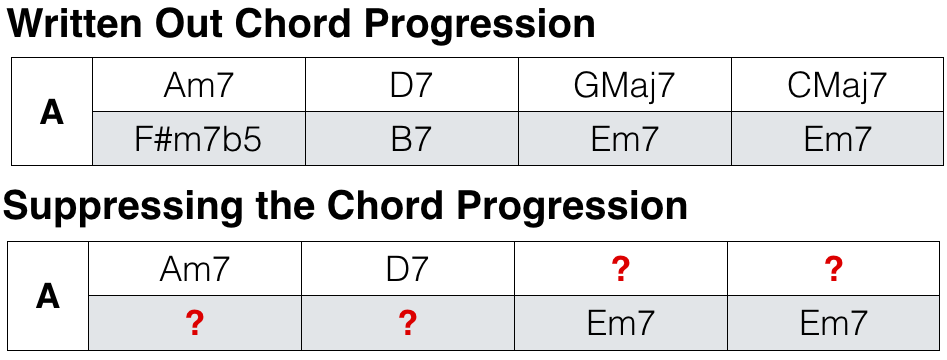Head-Solo-Head
Traditional Jazz songs follow a ‘Head-Solo-Head’ structure. Where the:
- Head = melody with underlying chord progression;
- Solo = improvising over that same chord progression.
By the 1960’s, this formula had gotten a bit boring and expected, so Jazz musicians started experimenting with different ways of structuring the overall performance of a song. And one of the ways this was done was by suppressing the chord progression and the melody of the ‘Head’. This technique was often used by Miles Davis’ Second Great Quintet (see Post-bop), especially when performing live, and especially when performing Jazz Standards.
Suppressing the Chord Progression
The point of playing the ‘Head’ or the initial melody is to introduce the Jazz song to the audience. This is to make sure they know exactly what song is being played and about to be improvised over. But there are a number of Jazz Standards that every Jazz listener known like the back of their hand. So there’s no real need to play the entire Head or melody for listeners to recognise the song. Instead, you only really need to play one or two opening phrases for the audience to identify the song, and then immediately start improvising and altering the chord progression. I’ve called this techinque ‘suppressing the chord progression’ or ‘suppressing the Head’.
Essentially, what you do is take a well-known Jazz Standard – like Autumn Leaves, which is a 32 bar AABC form – and play it while:
- keeping the underlying form/number of bars
- keeping the underlying meter/number of beats
- changing the chord progression (either by sitting on one chord for a long time or playing completely different chords) with the soloist improving over the top. And then, upon the soloists signal, returning to the melody and chord progression proper.

This gave the impression of the band slipping in and out of the song. But by keeping the underlying meter and form going, it keeps the whole thing grounded and smooth and still provides a strong link back to the actual song.
These new chords/solos weren’t written out beforehand, they were both completely improvised. So neither player knew what the other was going to do, they just had to listen and follow each other. The chords are improvised (playing any chord) and the solo is improvised (playing any note or scale) – so sometimes, they clashed. But that’s OK; after all, it’s Jazz.
Controlled Freedom
This technique was a direct response to Free Jazz, which used completely free improvisation, without too much regard for form or meter. In a sense, this is ‘controlled freedom’. You disposed of the underlying chords and melody, so could freely improvise however you liked, but still kept the underlying form and meter and referred back to the actual song occasionally. So you’re still playing the same song, but with some free improvisation added in.
Have a Listen to
For some great examples of this ‘Suppressing the chord progression’ technique being used during a performance, check out the following Miles Davis live albums:
- Miles in Tokyo
- Miles in Berlin
- Live at the Plugged Nickel